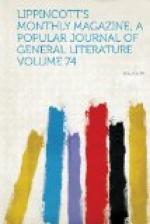It is a saying that an Englishman’s house is his castle, but the phrase is understood to be figurative: Mr. Ormiston’s house was his castle without a figure. Cockhoolet Castle is very old, at least one part of it is, having been built probably about the year 1400. A more modern part was built in 1527, while the most modern part of all was added in 1726: this last division of it is used as the farm-house. The rooms have been painted and papered in the present style of house decoration, and in the sitting-rooms, in addition to the little old windows, the thick walls have been pierced and a large bow-window put in with fine effect. There are three narrow stone staircases leading up the three divisions of the castle; there are long passages; there are sudden short flights of steps taking you up or down into all manner of cornered rooms; there is a hall which might hold the population of the county. Keeping up one of the spiral staircases, you come out on the roof, round which there is a walk guarded by a low stone coping: should you want to fling yourself over, you have ample opportunity. There are stone sentry-boxes where you can sit hidden from the wind and everything else, and look far and wide over the country, and down into the garden if you can do so without growing giddy. There is also a dungeon tenanted by nothing more subject to suffering than potatoes and other roots, for which it is a most favorable receptable, the walls being so thick and the roof so low that cold cannot get in in winter nor heat in summer: there is only a single narrow slit in the wall for the admission of light, but it is comforting to know that the doomed wretches who inhabited it in past ages had at least a temperate climate.
There is the room Queen Mary Stuart slept in when she occasionally visited in the vicinity. The reader is perhaps not familiar with Queen Mary’s name in connection with Cockhoolet Castle, but there may be other facts about her of which he is also ignorant. Does he know, for instance, that she had a daughter by her third marriage, whom, as an infant, she despatched to France to be reared in a nunnery, “that she may not,” said the unhappy queen, “run the risk of having such a lot as I have”? Does he know that John Knox was possessed by a mad passion of love for Mary Stuart? It has always been thought otherwise—that in point of fact he held her in contempt; but as it is proverbial that “nippin’ and scartin’ (figurative of course) is Scotch folks’ wooin’,” there may be truth in the new discovery. But true or not true, it is enough to make the bold Reformer blush standing on the top of his pillar in the necropolis of Glasgow: perhaps he is blushing, if he were near enough to see.
Be that as it may, there is no manner of doubt that Mary Stuart honored Cockhoolet Castle by abiding under its roof when it suited her to do so. Have not I, the present writer, stood in the room she slept in—looked from the small windows set in the ten-foot thick wall from which she looked? Have I not gazed over the same country, up to the same skies, into the same moon at which she gazed? Could her face be more fair than that of the present Rose of Cockhoolet, her thoughts more innocent, her reveries more sweet, than those of Bessie Ormiston, who in the course of time had succeeded to the room which had been consecrated by royal slumbers?




